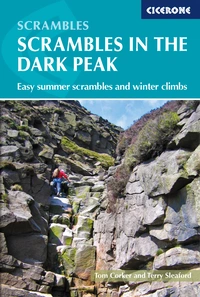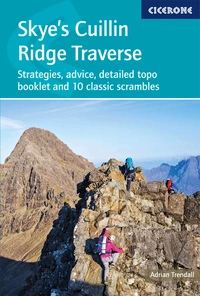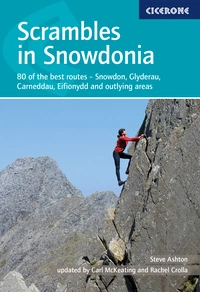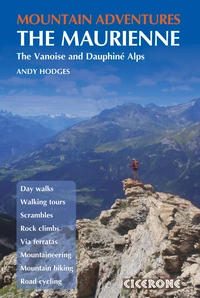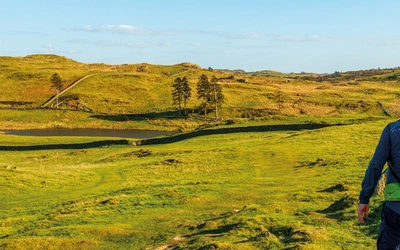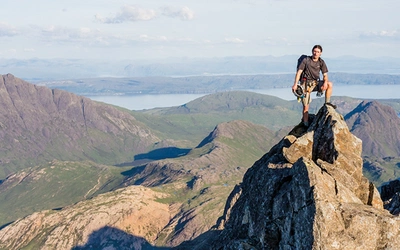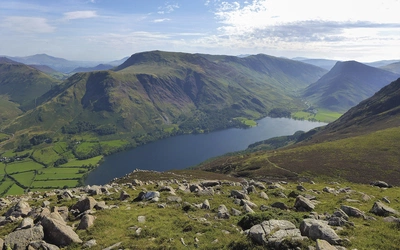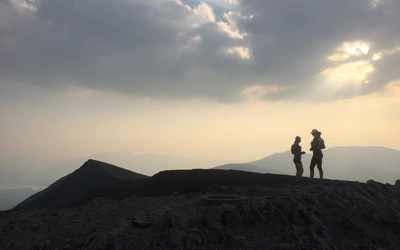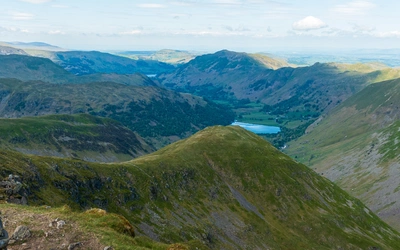Five of the best scrambles in the Lake District
The Lake District offers many scrambles, ranging from family-friendly rambles to iconic routes suitable only for experienced climbers. In his two guidebooks to 'Scrambles in the Lake District', John Fleetwood has recorded over 390 individual routes, from the old classic ridge lines to esoteric gills and obscure crags. Here are five of his favourite scrambling routes in the Lake District, plus notes on grading and quality rating.

Jack’s Rake (Grade 1, ***)
Jack’s Rake is a time honoured classic that belies its modest grade. It is one
of the most popular scrambles in Britain and with good reason, since
it takes a compelling line across a huge cliff that looks highly
improbable, but is revealed to be amenable. The route takes a diagonal
course across the face, forming a natural trough which makes for fine
situations, with exposure increasing as height is gained.
Like all of the best scrambles, Jake's Rake takes the easiest line in a difficult place, providing a window into the rock climber’s world. It is also a great viewing point for the many rock climbs that start or finish at the rake. In wet weather, it forms a natural channel that funnels all the water and this may reach your armpits!
A large path runs up to the tarn at its foot, but a much better approach is to scramble up the boisterous stream that falls from the tarn. Depending on the volume of water flowing, this also gives good scrambling on clean rock with several scenic falls. The line of Jack’s Rake is only too evident from the tarn – a diagonal line that rises right to left across the cliff of Pavey Ark. On a busy day you will see a line of people stretching the length of the rake. While the trough can be taken for maximum security, a more elegant alternative is the stepped left edge which can be taken to exit at a prominent tree. At one point you pass a ‘gun’ like block which makes a good photo opportunity, before a more open section leads to the knobbly summit of Pavey Ark. On a sunny day this is a popular place to eat lunch and stare at the glinting tarn below, buoyant from the exhilaration of your ascent.
Scrambles in the Lake District - South
Langdale, Coniston, Eskdale, Patterdale & High Street
£18.95
Guide to 106 scrambling routes climbing the rocks and ghylls of the English Lake District, covering the southern area including Langdale, Coniston and Eskdale. Routes range from grade 1 to V Diff (use of a rope is recommended for grade 2 and above) and can be linked to form 24 longer outings. With advice on equipment and safety.
More informationThe Bell (Grade 1, **)
There
are better routes in the Lake District but few more suited to young
children. The Bell is a delightful mini mountain, just a short walk
away from the upland car park at Walna
Scar. As such, it forms a suitable objective for those with little legs
and short attention spans.
The Bell is a craggy spur visible from the Walna Scar road. Reminiscent of Yewbarrow, The Bell looks like a mountain while proving accommodating for the novice scrambler and small children. This is a place for play, without the seriousness of higher mountains or more committing places. Yet, it still presents enough interest to keep the wee ones entertained. If they have their eyes set on the summits above, create a longer adventure by walking to the top of the Old Man of Coniston.
For adults who might spurn such a short outing, The Bell forms an entrée to a day which includes the open gill of Low Water Beck (Grade 3, ***), the surprisingly fine Brim Fell Slabs (Grade 2, **), and many more besides. Like many scrambles, consider The Bell an incident in a day of exploration and you won’t be disappointed.


Pillar Rock (Grade 3, ***)
Pillar Rock is one of Lakeland's famous crags and a summit that
defies the non-climbing hillwalker. The full frontal height of the crag
is almost 200m
and rears up from Pillar Cove like a colossal cathedral of the natural
world. This is not a place for the novice scrambler and should be treated as a mountaineering excursion.
This day constitutes a pilgrimage to one of Lakeland’s most impressive sights. Situated at the head of wild Ennerdale, Pillar Rock has a three hour approach and requires effort to reach. A day spent here is to savour the atmosphere of Lakeland's climbing history and marvel at the boldness of the original explorers who scrambled without the advantage of modern footwear and safety equipment. The line of the first ascent up the final rocks of High Man is uncertain, but there is no doubting the courage and boldness of John Atkinson, an Ennerdale cooper, who made the first ascent alone in 1826.
An approach from below gives an appreciation of the full majesty of the Rock, whilst a traverse of Old West and Slab and Notch, allows the full extent of this magnificent crag to be seen. The original way of Old West makes a great scrambling route, particularly as the descent is made by the Slab and Notch. Both are similar in difficulty, although the Old West has its awkward step high in an exposed position. The route is best appreciated when no one else is on the Rock, when the aura of a big mountain crag oozes from every mossy rock and overhang.
The Old West route is the popular classic way of reaching the summit of the imposing rock, first climbed in 1861. The varied route, which provides a lot of interest, is well trodden and very popular. However, take care, for the route is above steep crags with considerable exposure and the consequences of a slip would be grave. The holds are everywhere good, but great care is required, especially in the gully which can be quite greasy.
Don’t expect pristine rock scrambling – it’s more a weaving combination of grass and stone that makes a diagonal ascent between steep rock faces to the top of Low Man, followed by a steeper ascent of walls and terraces to High Man. The top is surprisingly flat and grassy, making a good place to stop and stare. But like big climbs in the Alps, you should be aware that the day is but half done, with no easy way off the Rock. Time honoured abseil tat indicates the easiest way down if you have a rope. More sportingly and if you have the time, a descent can be made of Slab and Notch route.
Whatever way you descend, make sure you walk up to the summit of Pillar Mountain for the retrospective views of the bulbous head of Pillar Rock, before wending your way homeward from the cathedral.

Link Cove Gill (Grade 3S or 3, ***)
Lakeland gills are one of the hidden pleasures of the District, offering sport and beauty in equal measure. With good rock and varied pitches, Link Cove Gill is one of the very best to explore.
Gill scrambling is something of an acquired taste that some find hideous and others consider to be the very best scrambling. It is the very antithesis of modern rock climbing – vegetated, slippy and often poorly protected. Yet gills are deeply beautiful with an energy created by the rushing water. The good rock and interesting pitches of great variety and beauty make Link Cove Gill a splendid expedition in one of Lakeland's most entertaining gills. Combined with the scramble on Greenhow End, it makes a fine route onto the Fairfield tops.
The gill itself is open with slabby cascades, rough knobbly rock and characteristic pool traverses. In all but dry conditions, you will get wet! Take a change of clothes, full waterproofs and an old pair of thick socks to put over your shoes to aid friction. The gill opens out into a wide amphitheatre which steepens at the top. This provides the crux passage of the direct route with an exhilarating pitch of Very Difficult rock climbing in the flow of the water. Setting up a top rope above the fall may be advisable here as the slabs are horribly slippery, even in socks. Alternatively, there are escape options from the halfway point where you can head left to an exposed finish below a tree, or take easier alternative climbs on the slabs on the right of the ravine. If you’ve taken the direct route – well done! Take a breather and dry off before embarking on more entertainment above.
Giant’s Crawl (Difficult, ***)
Dow Crag is the magnet drawing climbers to the Coniston area. It forms an impressive array of buttresses which are named alphabetically from left to right. Giant’s Crawl takes a ramp line up ‘B’ Buttress and forms one of the very best Difficult climbs in the Lake District.
Like all scrambling on Dow, Giant's Crawl is serious and can only be recommended to those with rock-climbing experience and route-finding ability. After a few days of dry weather in the summer, the rock is a delight. In the all-too-often damp conditions (it faces east), the rock can become an ice rink. Go when it’s dry and treat it as a rock climb – you’ll have a first-rate day out.
The route itself starts at the foot of the big gully and climbs easy slabs to a sloping ledge. A crack above leads to a sensational (and polished) gangway which forms a sort of ‘Traverse of the Gods’ above the abyss. An escape can be made onto Easy Terrace at
the far end of gangway, but the
fun continues by taking ledges left to an awkward block. This can be
overcome by a variety of means, some of the decidedly thuggish variety.
A grassy ledge then leads to a superb vantage point overlooking Great
Gully. A final steep crack leads to easier ground above and a
delightful ridge that takes you right to the top of the crag itself.
Scrambles in the Lake District - North
Wasdale, Ennerdale, Buttermere, Borrowdale, Blencathra & Thirlmere
£18.95
Guide to 100 scrambling routes climbing the rocks and ghylls of the English Lake District, covering the northern area, including Wasdale, Buttermere, Patterdale and Blencathra. Routes range from grade 1 to V Diff (use of a rope is recommended for grade 2 and above) and can be linked to form 24 longer outings. With advice on equipment and safety.
More informationGrading
Grading is inherently subjective but gives a guide as to the difficulty of the route. Rock climbing grades are used for routes commonly climbed as roped rock climbs. The grades apply to ascents in good dry conditions. Wet rock, particularly on the crags, can increase the grade considerably or render a scramble extremely hazardous.
- 1: A straightforward scramble, with little or no route-finding difficulty. The described route takes the most interesting line, which can usually be varied or even avoided at will. Generally, the exposure is not significant, but even so, great care must be taken to avoid a slip.
- 2: Contains longer and more difficult stretches of scrambling, and a rope may be useful for ensuring safety for inexperienced or nervous scramblers. Although individual sections of the scramble can usually be avoided, these sections may be inescapable once the scramble is underway. Some skill in route finding is required to follow the described line.
- 3: A more serious proposition, only to be undertaken by competent parties. Escape is difficult. A rope is advisable for safety on exposed passages and for some pitches of easy rock climbing. The routes require a steady leader with the ability to judge how the rest of the party are coping with the situations, and a rope should be used wherever the safety of an individual is in doubt.
- 3S: A particularly serious outing, often involving poor rock or vegetation, and may include steep pitches of rock climbing. Recommended only for experienced, competent climbers who will almost certainly use a rope on key pitches. Escape is difficult.
- M: Moderate rock climb
- D: Difficult rock climb
- VD: Very Difficult rock climb
A star rating applies to the overall quality
of the route, considering not just the scrambling itself but situation,
continuity and length.
- * Worth climbing but may be discontinuous, short or lacking in continuous interest.
- ** A route of more continuous interest and a good line.
- *** A classic route with continuously interesting scrambling that is based on a good line.
For more health and safety information, here is an online guide on how to scramble safely, written by John Fleetwood.



